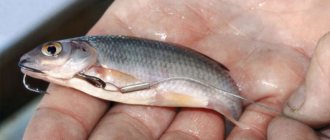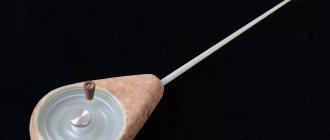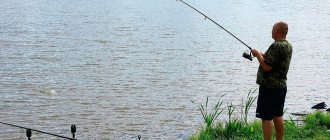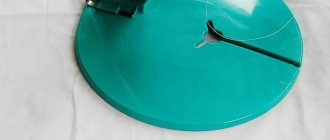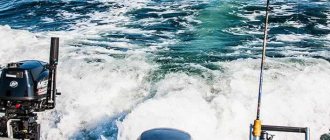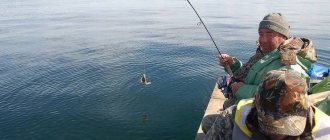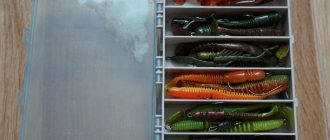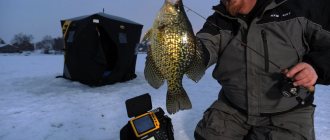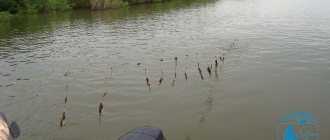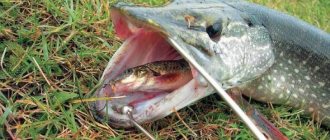For what fish is this tackle with appropriate bait used?
You don’t need to think that by attaching any fish to a girder, you can pull out any predatory fish that lives in a reservoir. There are certain recommendations regarding the choice of live bait in accordance with the intended purpose. They are as follows:
- Pike – almost all types of fish as live bait. Preference is given to large live bait, preferably species of fish that live in the reservoir in which fishing takes place, during the period of high activity of the predator and smaller ones when it is passive. Crucian carp is considered a universal bait.
- Pike perch are small fish with a thin body: bleak, gudgeon, dace, roach, ruff. On the Volga they use sprat, but not live, but dead, hooking it in a special way.
- Perch – live bait of small length: roach, perch, ruffe, dace, gudgeon, loach.
- Burbot - any live bait, including dead and even pieces of it, but if possible, ruff or roach.
- Ide and chub are small roach or spruce trees.
- Catfish are large live bait fish. If the live bait turns out to be too lively, its fins are trimmed.
Expert opinion
Knipovich Nikolai Mikhailovich
Zoologist, hydrobiologist. I am interested in fishing at a professional level.
In some places they catch lamprey larvae - minnows, which cling very tightly to the hook and do not fall asleep for a long time. The bait is dug into the sandy banks.
Varieties of girders
- Flat base. The disk vent floats on water or is installed on ice;
- Kaganok. Vertical vent with reel;
- Vertical stand. The zherlitsa is stuck into snow or ice.
Summer zherlitsa
- Postavukhi. Live bait is hooked and thrown into the water. The second end of the tackle is secured on the shore (by a peg or hook). The trick: to prevent the fish from leaving, you need to make 1.5 - 2 meters of free line;
- Hanging. A wooden slingshot with a cord is suspended from a tree or stick above the water. The live bait is lowered into the water along with the sinker. When biting, the slingshot will begin to relax the line;
- With a reel. A peg with a rope is driven into the shore, the tackle with live bait is thrown into the water. When biting, the coil will begin to unwind, releasing the signaling flag;
- Floating. A round flat float is made, onto which a flag is attached, on the opposite side of the fishing line with live bait. A fishing line is attached to the edge of the float, which will be controlled by the fisherman from the shore. In order for the fish to move better to the girder, fishermen recommend securing grass along the edges of the circle.
Let's celebrate! All types of summer girders can be made with your own hands; the main condition will be a sufficient amount of fishing line. If the predator feels that the prey is not doing well, it will immediately release it.
Winter zherlitsa
- Postavukhi. The structure can stand all winter. Its main principle: the bait with live bait is located in a hole under water. To check or get the catch, you need to drill another hole nearby and pick up the girder with a hook. Trophies are pulled out through a new hole;
- Plates. Budget option for winter fishing. The basic principle: the “plates” completely cover the hole and then signal the catch. The main disadvantage of this design is that fish are caught from under the “plates”;
- Homemade. A wire spool is attached to a wooden rod. When it freezes, the structure can be covered with snow, which will prevent the hole from freezing.
- Rack. The pointed end of the girder is stuck into the snow, and a signaling flag is installed on the opposite side. In the middle of the structure is a reel with a fastening mechanism;
- Tripod. The principle is the same: the reel and line are between the legs, and the flag is on the top;
- Load-bearing base. Homemade wooden plates on which legs and a flag are installed. The legs can be made to any position, it all depends on the preferences of the fisherman. The main advantage of such girders is the complete closure of the holes.
Good to know! In winter, fishermen are advised to use girders that can completely cover the hole. This will help reduce the time when searching for the girder and will guarantee that the fish will not “slip off”. It is also worth purchasing bright flags in advance and additionally gluing them so that sharp gusts of wind do not tear them off.
About the hooks on which it is better to put bait
For fishing on girders, both single, double and triple hooks are used. The choice of hook is dictated by the type of fish being hunted and the rigging method used. So, if you are catching a perch or a “white” predator, you use, first of all, single fishing rods. If it is required that the live bait remains active as much as possible, doubles and trebles are used, which are not stuck into the body of the live bait.
What should you consider before dressing?
Before you start placing live bait on a hook, you should consider the following circumstances:
- Fishing takes place in a standing or flowing body of water. In strong currents, it is practiced to attach live bait by the nostrils or lips.
- How long should baitfish remain active? The least traumatic method for live bait is to thread a leash through the gills, as well as tying live bait if the angler has certain skills.
- In what position should baitfish be in the water? In most cases, the horizontal position of the live bait is considered optimal, but sometimes other approaches are required.
- What size live bait is used? The size of the bait affects the size and type of hook, and sometimes you have to hook the fish on two hooks.
Live bait bait when fishing with girders
Another fascinating and effective method used by fishermen for a very long time is the circle. It is a disk about 2 centimeters thick and 10-15 cm in diameter. A supply of fishing line is wound in the end groove, and a pin is located in the center. On one side it has a groove into which the fishing line is passed, on the other there is a limiter, usually brightly colored. The top side of the circle is red and the bottom is white.
They fish with mugs in two ways, but always from a boat:
Live bait does not imitate fish, unlike spinners, vibrotails and other factory baits, but is a real live fish that has characteristic behavioral characteristics in the water, which, in turn, naturally stimulate the appetites of predators.
Thus, we can say with complete confidence that catching predatory fish with live bait is not only exciting, but in most cases it is more productive than using artificial bait.
The operation of placing live bait by the lip looks like this:
Ways to keep bait alive
There are long-term and short-term storage of live bait. During long-term storage, the following rules should be followed:
- keep live bait in a spacious container;
- keep live bait in a cool place;
- aerate the water containing live bait;
- change the water periodically;
- avoid changes in water temperature in containers with live bait;
- remove dormant live bait in a timely manner;
- do not feed live bait.
Expert opinion
Knipovich Nikolai Mikhailovich
Zoologist, hydrobiologist. I am interested in fishing at a professional level.
In order for live bait to remain alive for as long as possible while fishing, they should be kept in a spacious container (the best option is kan). Change the water periodically and try to keep the container with live bait out of the sun (in summer). In winter, you need to make sure that the water in the dishes does not freeze.
How to cling correctly?
Baiting bait can be done in several ways , and each has its own tricks.
For one lip
The operation of placing live bait by the lip looks like this:
- The live bait is held in the palms of the hands.
- With the other hand, take the hook by the fore-end.
- They pierce the upper lip of the baitfish with the sting of the hook.
Expert opinion
Knipovich Nikolai Mikhailovich
Zoologist, hydrobiologist. I am interested in fishing at a professional level.
With this method of mounting, a single hook is most often used.
Through the gills
It is possible to insert live bait through the gills if the angler has certain skills. For this method, you cannot use any leashes. The leash must have a certain rigidity and have a loop at the end. Steel leashes made of string or vole or twisted wire are suitable for this method.
The bait fish on the hook must remain mobile. Therefore, when fishing with live bait baited through the gill cover and mouth, two-piece leashes are used.
There are two ways to properly hook live bait through the gill. The first is this:
- One end of the leash is tied to the main fishing line wound around the girder.
- The free end of the leash with a loop at its end is threaded under the gill and taken out through the mouth of the baitfish.
- A double is put on the loop.
- They drag the leash back so that only the hook sticks out of the baitfish’s mouth.
The second way is as follows:
- A fastener is attached to the end of the main line.
- At the end of the leash, a hook of any type is mounted: through a winding ring or in some other way.
- The free end of the leash is threaded into the fish's mouth and out through the gill. The leash is attached to the clasp.
Expert opinion
Knipovich Nikolai Mikhailovich
Zoologist, hydrobiologist. I am interested in fishing at a professional level.
However, leashes are only necessary when hunting pike and catfish. To catch other fish there is no need to install a leash, although a short fluorocarbon one will not be superfluous.
For both lips
The bait is attached to both lips in exactly the same way as to one . The lower lip is pierced from the outside, and then the hook tip is pulled out through the upper lip. With the described method of baiting, live bait does not live so long, since it is not able to fully breathe.
Behind the nostrils
Installation by the nostril is carried out in the same way as by the lip, i.e. by piercing with a hook any nostril of the baitfish from the inside. A fish attached by the nostril holds tighter than one attached by the lip, since the nostril is located slightly further from the edge of the mouth.
Behind the back
The method of attaching live bait to the back is very widespread, but even here you need to know about some subtleties.
- In particular, under no circumstances should the spine of the live bait be harmed, so the puncture is made directly under the dorsal fin or, much less frequently, below the spine.
- The second important condition is that the live bait must be positioned horizontally in the water.
- The position of the fish with its head up is considered unacceptable.
Expert opinion
Knipovich Nikolai Mikhailovich
Zoologist, hydrobiologist. I am interested in fishing at a professional level.
You can attach live bait behind the back using single, double and triple hooks.
By the tail
Placing a fish used as live bait by the tail differs from that by the back only in that the puncture is made closer to the caudal fin of the fish. Live bait baited in this way behaves more actively, thereby provoking the predator to bite.
Double puncture
Placing live bait with a double puncture is used when it is necessary for the predator to be more reliably detected. This method is common when catching pike perch using sprat or dead bleak. Use a single hook. Live bait is attached like this:
- They pierce the back of the baitfish between the head and the dorsal fin.
- They take the sting out and make a puncture closer to the tail.
Tying
The tying method is used when they want to completely avoid injury to live bait. To do this, the live bait is tied with thread or an elastic band for banknotes and a hook is inserted under it.
Two hooks
Two treble hooks are used when large live bait is used to catch predatory fish. An additional hook is placed on the leash. One hook is stuck into the back of the baitfish, the second is hooked onto its upper lip.
For fishing with girders, soft leashes are used , except in cases where they are used under the gill.
Expert opinion
Knipovich Nikolai Mikhailovich
Zoologist, hydrobiologist. I am interested in fishing at a professional level.
For such fishing, multi-strand metal leashes or leashes made of a special soft material are used, which can be used to tie fishing knots, and sometimes thick fluorocarbon is also used.
The latter has some rigidity, but the “invisibility” of the material makes up for this drawback.
Choose the best, so how to properly attach live bait
It is impossible not to note the craving of specific pike fishers for a wide variety of equipment. The vast majority have tried different options in their fishing, choosing the best one for themselves. Often not one, but several, all favorite, used according to the situation and mood. I was reminded of this by a 10.8 kg pike caught with a girder at the beginning of this season at the reservoir.
I took the trophy in a bay formed by a small flowing river. In the bite area there is a sandbank of about 1.5 m, next to an old water lily. The bite occurred in the deepening evening twilight, and it’s good that I didn’t take off ahead of time. I took about 5 cm of crucian carp, hooked with one double hook on the back, but not under the dorsal fin, but closer to the tail - when in weight, the fish hangs head down, about 30 degrees, in this version my bites are realized much better.
Not all of my winter vents are equipped equally. On every fishing trip I try a variety of options. I can rig a couple of rigs “for gulp”, putting a leash under the gill. Perhaps this option will work better today, then I’ll transfer the rest of the zherlits to it. Often the “swallow” option helps out when, in the absence of bites, I decide to look a little further for pike, and the remaining gear is designed to catch the fish themselves - they are under supervision, but it’s too far away, I don’t want to run, and I may not have time if I hook a double under the back .
[THERE IS AN ANSWER] How to tie a jig on a winter fishing rod?
And one more important point when catching pike with live bait : when fishing in open water with circles, my “swallow” equipment usually works significantly. I don’t know what the reason is. Perhaps I’m running towards the winter shift faster than I’m getting to the summer shift. So different pike rigs are important, different ones are needed!
The treble hook pierces the muscles on the fish's back and is attached to a leader threaded through the mouth and gills.
Errors when planting
Placing live bait on a baitfish hook is usually accompanied by the following errors:
- Inaccurate placement leading to the death of live bait. You can avoid this by always working with wet hands, since touching the fish with dry hands leads to thermal burns, and also by trying not to squeeze the bait too much.
- Using the wrong size or type of hooks. Live bait should look natural when hooked. This disadvantage can be eliminated by using appropriate hooks.
- Using a baiting method that does not correspond to fishing conditions, the properties of live bait and its size. For different methods of fishing with girders, as well as for catching different fish, it is necessary to select the optimal method of attaching live bait.
If an angler wants to catch a predatory fish on a pole, he must, among other subtleties, know how to properly place live bait on a pole. Although, in addition to this condition, there are many more nuances of girder fishing, this rather simple job must be performed flawlessly.
